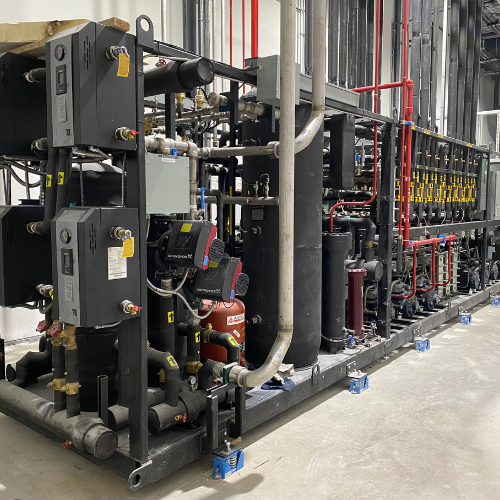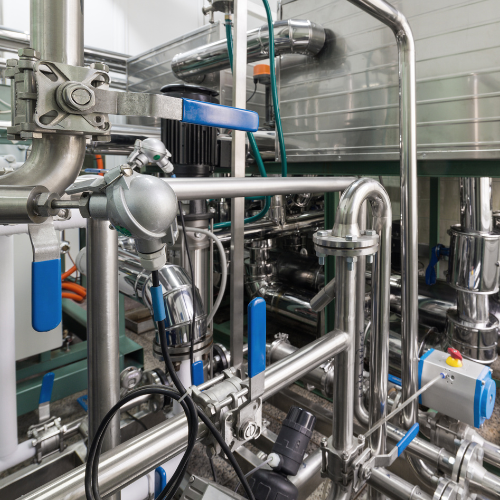“We knew we wanted a CO2 system from the start. It aligned with our vision of sustainable agriculture and a net zero future. Energy efficiency was also a key consideration and we were happy with the projected performance of the CO2 solution.” - Edith Desrosiers, Project Management Director
INDUSTRY
Food and Beverage
PROJECT
Design, Build, Installation, Commissioning, and Maintenance
PROJECT CONTACT
Paolo Pecora, Sales Manager, Montreal
Overview
The uptake of CO2 (R744) systems in both recreational and industrial applications is steadily increasing in Quebec as acceptance of this sustainable technology grows. To date, CIMCO has already installed more than 35 CO2 systems in Quebec alone, serving a mix of industrial and recreational projects.
Thanks to proven energy efficiency and negligible direct emissions potential, CO2 is quickly becoming the preferred choice in especially Quebec, a province known for its ultra-ambitious climate policies and net zero goals.
“As acceptance of the technology continues to grow in tandem with available grants and subsidies for sustainable projects, CIMCO expects a further boom in CO2 installations in Quebec as well as the greater Canadian region,” said Paolo Pecora, Sales Manager for Montreal at Toromont Industries, CIMCO’s holding company.
Introducing Rooftop Greenhouses
One company that needed no convincing about the sustainability and benefits of going CO2, was Lufa Farms in Ville Saint-Laurent. It is changing the face of urban agriculture through its produce-to-order growing strategy that feeds thousands from rooftop greenhouses.
Lufa grows more than 500,000 ft2 of fresh, local, responsible vegetables. It does so hydroponically on an increasing number of city rooftops to feed surrounding customers more sustainably.
The farm is the brainchild of Canadian Mohamed Hage and his wife Lauren Rathmell who wanted to find a more sustainable and responsible way to grow food, going straight to the consumer and avoiding larger retail chains. And so, Lufa Farms was born in 2009 to produce food as close to its consumers as possible without using any additional land. The solution? Urban rooftops, transforming existing buildings into sustainable greenhouses right in the city.
Committed to the principles of sustainable agriculture, Lufa Farms built the world’s first commercial rooftop greenhouse in Montreal in 2011—a 32,000ft2 (2,973m2 ) steel-and-aluminum structure. The first greenhouse was in Ahuntsic and since then, three additional rooftops have been added: Laval, Ville Saint-Laurent, and Anjou.
Choosing Sustainable CO2 Refrigeration
When retrofitting an existing building into its latest greenhouse operation, CIMCO worked with Lufa Farms’ refrigeration consultant to design, build, and install a packaged CO2 system to serve the post-harvest cooling needs of the urban farm.
The 276 TR (971 kW) CO2 system maintains varying temperatures for both fresh and frozen produce once it has been harvested from the urban farm. The scope of the work also comprised constructing a freezer, ice pack, refrigerator, and cooldown room. Plus all the required piping, insulation, etc, necessary for the complete refrigeration installation.
Benefits of CO2
When choosing the refrigeration system, the customer had a very clear idea of their needs. “We knew we wanted a CO2 system from the start. It aligned with our vision of sustainable agriculture and a net zero future,” said Project Management Director, Edith Desrosiers. “Energy efficiency was also a key consideration and we were happy with the projected performance of the CO2 solution.”
Choosing CO2 had other benefits too, like lower maintenance costs and reduced risk of costly refrigerant leaks. Not only that, but also peace of mind for the customer that the installation would not have to be replaced before the end of equipment life due to ongoing refrigerant phase downs affecting fluorinated gases (f-gases).
Quebec has some of the most ambitious climate policies and goals in the country. It has banned the use of f-gases with a global warming potential (GWP) greater than 150 in installations of 50 kW and above. With a GWP of only 1, CO2 is the ideal choice for these installations. Using an f-gas with a greater GWP would mean installing multiple small units (under 50 kW), which generally increases the maintenance work and often the energy usage too.
CIMCO Goes the Extra Mile
As is common with retrofitting a refrigeration system to an existing building, the team ran into various challenges which were swiftly and professionally dealt with.
Challenges like getting the equipment up the elevator, which was solved by splitting the package up into seven parts and reassembling it in the plant room. Or like getting the four large gas coolers onto the roof, which CIMCO managed to arrange a helicopter (and necessary permits) for.
The project was completed in 2022 with CIMCO also executing the maintenance contract for the facility, servicing and maintaining the system on an ongoing basis.
.png?sfvrsn=3363c522_0)
Related Posts

DesLaurier Cold Storage

Comparison of Key Refrigeration System Components: Making the Right Choice for Your Operation
.png?sfvrsn=26cbdc22_3)
Ammonia Heat Pumps Achieve 185°F, Ditch the Boiler for Food & Beverage Production
|
|

.png?sfvrsn=6960c522_0)

